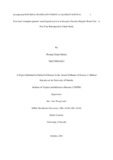| dc.contributor.author | Mwangi, Elijah G | |
| dc.date.accessioned | 2014-12-10T12:52:55Z | |
| dc.date.available | 2014-12-10T12:52:55Z | |
| dc.date.issued | 2014-10 | |
| dc.identifier.citation | Degree of Masters of Science in Medical Statistics at the University of Nairobi, Institute of Tropical and Infectious Diseases (UNITID) | en_US |
| dc.identifier.uri | http://hdl.handle.net/11295/77130 | |
| dc.description.abstract | Renal transplantation has become the treatment of choice for most patients with end stage renal
disease (ESRD). Marked improvements in early graft survival and long-term graft function have
made kidney transplantation a more cost-effective alternative to dialysis.
This study was aimed at determining the patient and renal allograft survivals and identifying the
factors impacting on survival following kidney transplantation at Kenyatta National Hospital.
94 kidney transplant recipients who underwent renal transplant at Kenyatta National Hospital
from January 2010 to February 2014 were considered for the study. Survival analysis was used
in the analysis to assess the role of explanatory factors in time to death of a patient and time to
rejection of a kidney allograft. Outcome measures studied were patient and graft survival. Graft
loss was defined by the need for permanent renal dialysis, repeat transplantation or death with a
functioning graft. Kaplan-Meier method was be used to determine patient and graft survivals.
Cox proportional hazard model was used to determine the factors affecting survival. The
patients’ survival for the first year was 88.7%, second year 88.7%, third year 88.7% and 82.6%
for the fourth year. The trend showed that the survival was the same for the first three years then
a drop on the fourth year. For the patients who survived the operation, their survival was 92.7%
for the first, second and third year post transplant. The fouth year survival was 85.7%. The renal
allograft survival was 92.01% for the first and the second year, and 83.01% for the third and
fourth year. The graft survival for those who survived the transplant was 97.36 for the first and
the second year and 88.02% for the third and fourth year.
The factors that significantly influenced survival of renal transplanted patients were presence of
diabetes mellitus (p-value- 0.032) and the level of antigens of the human leukocyte antigen
(HLA) mismatch (p-value<0.0001). Factors that significantly influenced allograft survival werepresence of Systemic lupus erythematosus (SLE) (p- value =0.025) and employment (p-value
=<0.0001). The results of the study concurred with other studies done elsewhere. In conclusion,
the study established that the survival rates in Kenyatta national hospital were good | en_US |
| dc.language.iso | en | en_US |
| dc.publisher | University of Nairobi | en_US |
| dc.title | Post renal transplant patients’ and allograft survival at Kenyatta National Hospital Renal Unit: a four year retrospective cohort study | en_US |
| dc.type | Thesis | en_US |
| dc.description.department | a
Department of Psychiatry, University of Nairobi, ; bDepartment of Mental Health, School of Medicine,
Moi University, Eldoret, Kenya | |
| dc.type.material | en_US | en_US |

